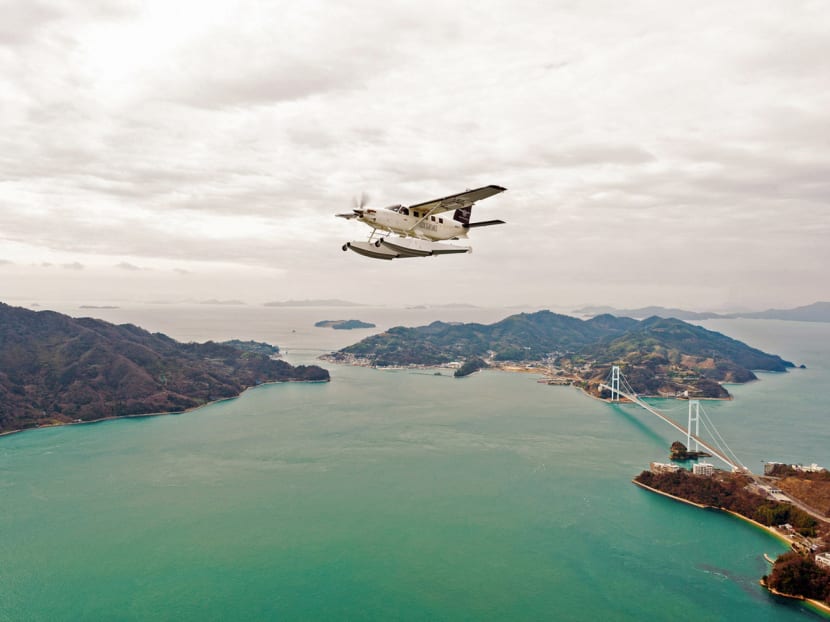Seaplanes in Japan soar back to popularity on tourism wave
HIROSHIMA — Seaplanes used to be a common form of transportation in the Japanese archipelago, with scheduled cargo and passenger flights operating mainly in western Japan until the mid-1960s.

Setouchi Seaplanes offers sightseeing trips over the isles of Innoshima and Noshima as well as other islands. Photo: Setouchi Seaplanes
HIROSHIMA — Seaplanes used to be a common form of transportation in the Japanese archipelago, with scheduled cargo and passenger flights operating mainly in western Japan until the mid-1960s.
The development of Shinkansen bullet trains and regional airports enabled faster transport links with greater capacities, leading to the phasing out of seaplanes.
Decades later, however, seaplanes are drawing renewed attention, chiefly for tourism in remote areas of the country where infrastructure costs are prohibitive.
A company in Onomichi in Hiroshima prefecture, on the Seto Inland Sea coast, launched seaplane services for sightseeing on Aug 10, the first such business started in Japan in roughly half a century.
A Setouchi Seaplanes amphibious Kodiak 100 took off early last month from Onomichi Floating Port with five passengers, flying around 500m over the isles of Innoshima and Noshima for nearly an hour. The trip, costing around ¥24,000 (S$320) per person — a campaign weekday fare throughout the month — provided views of these and other islands in the emerald-green inland sea.
Setouchi Seaplanes vice-president Takenori Matsumoto explained that the business is aimed chiefly at revitalising the economies of regional cities such as Onomichi and Fukuyama, also in Hiroshima prefecture.
The company, which operates a fleet of four Quest aircraft, is a unit of Setouchi Holdings Inc, part of the Tsuneishi shipbuilding group. The holding company acquired Quest Aircraft, the American maker of Kodiak planes, in February.
Mr Matsumoto is confident about the future of Setouchi Seaplanes’ sightseeing business. “The landscape of the Seto Inland Sea islands from a low altitude is magnificent,” he said. “We will be profitable in the long run.”
Although seaplanes are susceptible to high waves and restricted to daylight operations due to visibility, the company is considering starting passenger flights linking the Seto Inland cities with Tokyo or Osaka, and envisages eventually building a nationwide network of seaplane services.
Professor Tomoyuki Todoroki, a Nihon University professor of transport system engineering, said Setouchi Seaplanes’ launch has given momentum to seaplane projects in other parts of Japan.
Working with Setouchi Seaplanes, Matsue, the capital of Shimane prefecture on the Sea of Japan coast, for instance, is planning a full-fledged service at Nakaumi, one of the largest brackish lakes in Japan, sometime in the next fiscal year starting April.
Mr Yuji Fukuma, who heads the city’s regional promotion division, expressed hope for sightseeing flights over the Shimane Peninsula, saying, “We hope to provide a tour (using seaplanes) because (adjacent) Sakai port accommodates cruise ships from abroad.”
The city of Matsue is responsible for providing infrastructure such as a pier, while Setouchi Seaplanes will oversee flight operations and marketing.
According to Prof Todoroki, other regions in Japan have also shown an interest in seaplanes. The city of Kamiamakusa in Kumamoto Prefecture once contemplated island-hopping flight tours, while local governments in Ibaraki Prefecture are considering inviting a seaplane operator. They are located around Kasumigaura, a lake where seaplane services originated in Japan in the early 20th century.
Prof Todoroki says he sees a role for seaplanes in Prime Minister Shinzo Abe’s push to revitalise regional economies because the aircraft can provide swift transport to destinations off the grid of the nationwide network of the bullet trains. “They can take off and land if there is an inlet 1,000m long,” he said.
There is also other potential for tourism. The trip from Tokyo to the Lake Chuzenji region in Tochigi Prefecture, which draws throngs of tourists for its autumn colours, for instance, could be cut to half an hour from around five hours by car.
Prof Todoroki noted that seaplanes can also be an asset in emergency situations such as providing relief and transporting sick people from remote areas in the event of an earthquake. KYODO NEWS






